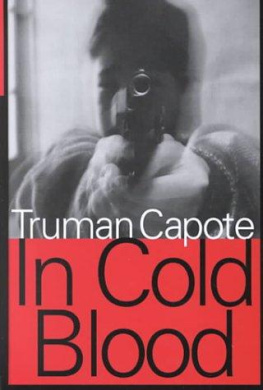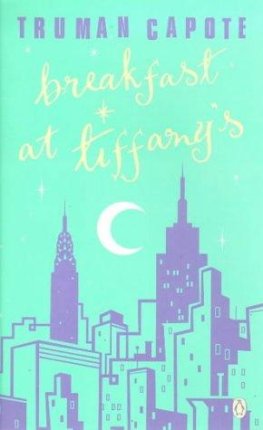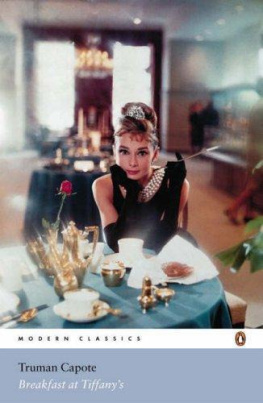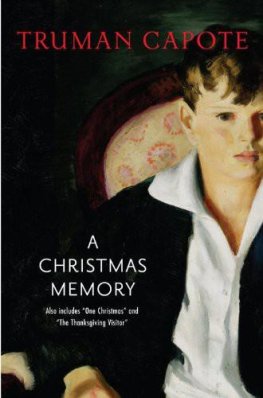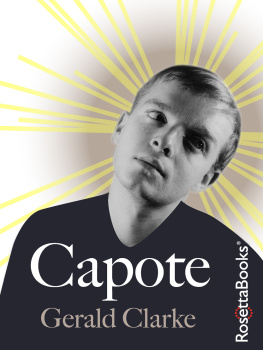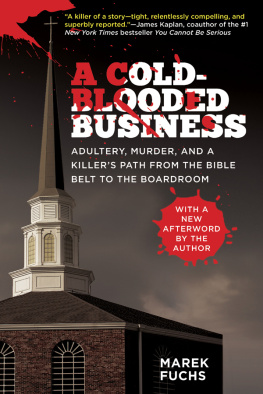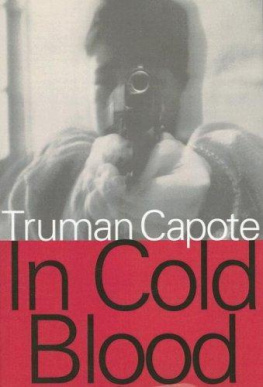Truman Capote - In Cold Blood
Here you can read online Truman Capote - In Cold Blood full text of the book (entire story) in english for free. Download pdf and epub, get meaning, cover and reviews about this ebook. year: 1994, publisher: Vintage, genre: Detective and thriller. Description of the work, (preface) as well as reviews are available. Best literature library LitArk.com created for fans of good reading and offers a wide selection of genres:
Romance novel
Science fiction
Adventure
Detective
Science
History
Home and family
Prose
Art
Politics
Computer
Non-fiction
Religion
Business
Children
Humor
Choose a favorite category and find really read worthwhile books. Enjoy immersion in the world of imagination, feel the emotions of the characters or learn something new for yourself, make an fascinating discovery.
- Book:In Cold Blood
- Author:
- Publisher:Vintage
- Genre:
- Year:1994
- Rating:5 / 5
- Favourites:Add to favourites
- Your mark:
- 100
- 1
- 2
- 3
- 4
- 5
In Cold Blood: summary, description and annotation
We offer to read an annotation, description, summary or preface (depends on what the author of the book "In Cold Blood" wrote himself). If you haven't found the necessary information about the book — write in the comments, we will try to find it.
National Bestseller
On November 15, 1959, in the small town of Holcomb, Kansas, four members of the Clutter family were savagely murdered by blasts from a shotgun held a few inches from their faces. There was no apparent motive for the crime, and there were almost no clues.
As Truman Capote reconstructs the murder and the investigation that led to the capture, trial, and execution of the killers, he generates both mesmerizing suspense and astonishing empathy. In Cold Blood is a work that transcends its moment, yielding poignant insights into the nature of American violence.
In Cold Blood — read online for free the complete book (whole text) full work
Below is the text of the book, divided by pages. System saving the place of the last page read, allows you to conveniently read the book "In Cold Blood" online for free, without having to search again every time where you left off. Put a bookmark, and you can go to the page where you finished reading at any time.
Font size:
Interval:
Bookmark:
ACKNOWLEDGMENTS
All the material in this book not derived from my own observation is either taken from official records or is the result of interviews with the persons directly concerned, more often than not numerous interviews conducted over a considerable period of time. Because these collaborators are identified within the text, it would be redundant to name them here; nevertheless, I want to express a formal gratitude, for without their patient co-operation my task would have been impossible. Also, I will not attempt to make a roll call of all those Finney County citizens who, though their names do not appear in these pages, provided the author with a hospitality and friendship he can only reciprocate but never repay. However, I do wish to thank certain persons whose contributions to my work were very specific: Dr. James McCain, President of Kansas State University; Mr. Logan Sanford, and the staff of the Kansas Bureau of Investigation; Mr. Charles McAtee, Director of the Kansas State Penal Institutions; Mr. Clifford R. Hope, Jr., whose assistance in legal matters was invaluable; and finally, but really foremost, Mr. William Shawn of The New Yorker, who encouraged me to undertake this project, and whose judgment stood me in good stead from first to last.
T.C.
T HE M ODERN L IBRARY E DITORIAL B OARD
Maya Angelou
Daniel J. Boorstin
A. S. Byatt
Caleb Carr
Christopher Cerf
Ron Chernow
Shelby Foote
Vartan Gregorian
Charles Johnson
Mary Karr
Jon Krakauer
Edmund Morris
Michael Ondaatje
Elaine Pagels
David Remnick
John Richardson
Arthur Schlesinger, Jr.
Carolyn See
William Styron
Gore Vidal
TRUMAN CAPOTE
Truman Capote was born Truman Streckfus Persons on September 30, 1924, in New Orleans. His early years were affected by an unsettled family life. He was turned over to the care of his mothers family in Monroeville, Alabama; his father was imprisoned for fraud; his parents divorced and then fought a bitter custody battle over Truman. Eventually he moved to New York City to live with his mother and her second husband, a Cuban businessman whose name he adopted. The young Capote got a job as a copyboy at The New Yorker in the early forties, but was fired for inadvertently offending Robert Frost. The publication of his early stories in Harpers Bazaar established his literary reputation when he was in his twenties, and his novels Other Voices, Other Rooms (1948), a gothic coming-of-age story that Capote described as an attempt to exorcise demons, and The Grass Harp (1951), a gentler fantasy rooted in his Alabama years, consolidated his precocious fame.
From the start of his career Capote associated himself with a wide range of writers and artists, high-society figures, and international celebrities, gaining frequent media attention for his exuberant social life. He collected his stories in A Tree of Night (1949) and published the novella Breakfast at Tiffanys (1958), but devoted his energies increasingly to the stageadapting The Grass Harp into a play and writing the musical House of Flowers (1954)and to journalism, of which the earliest examples were Local Color (1950) and The Muses Are Heard (1956). He made a brief foray into the movies to write the screenplay for John Hustons Beat the Devil (1954).
Capotes interest in the murder of a family in Kansas led to the prolonged investigation that provided the basis for In Cold Blood (1966), his most successful and acclaimed book. By treating a real event with fictional techniques, Capote intended to create a new synthesis: something both immaculately factual and a work of art. However its genre was defined, from the moment it began to appear in serialized form in The New Yorker the book exerted a fascination among a wider readership than Capotes writing had ever attracted before. The abundantly publicized masked ball at the Plaza Hotel with which he celebrated the completion of In Cold Blood was an iconic event of the 1960s, and for a time Capote was a constant presence on television and in magazines, even trying his hand at movie acting in Murder by Death.
He worked for many years on Answered Prayers, an ultimately unfinished novel that was intended to be the distillation of everything he had observed in his life among the rich and famous; an excerpt from it published in Esquire in 1975 appalled many of Capotes wealthy friends for its revelation of intimate secrets, and he found himself excluded from the world he had once dominated. In his later years he published two collections of fiction and essays, The Dogs Bark (1973) and Music for Chameleons (1980). He died on August 25, 1984, after years of problems with drugs and alcohol.
I
THE LAST
TO SEE THEM ALIVE
T he village of Holcomb stands on the high wheat plains of western Kansas, a lonesome area that other Kansans call out there. Some seventy miles east of the Colorado border, the countryside, with its hard blue skies and desert-clear air, has an atmosphere that is rather more Far West than Middle West. The local accent is barbed with a prairie twang, a ranch-hand nasalness, and the men, many of them, wear narrow frontier trousers, Stetsons, and high-heeled boots with pointed toes. The land is flat, and the views are awesomely extensive; horses, herds of cattle, a white cluster of grain elevators rising as gracefully as Greek temples are visible long before a traveler reaches them.
Holcomb, too, can be seen from great distances. Not that there is much to seesimply an aimless congregation of buildings divided in the center by the main-line tracks of the Santa Fe Railroad, a haphazard hamlet bounded on the south by a brown stretch of the Arkansas (pronounced Ar-kan-sas) River, on the north by a highway, Route 50, and on the east and west by prairie lands and wheat fields. After rain, or when snowfalls thaw, the streets, unnamed, unshaded, unpaved, turn from the thickest dust into the direst mud. At one end of the town stands a stark old stucco structure, the roof of which supports an electric signD ANCE but the dancing has ceased and the advertisement has been dark for several years. Nearby is another building with an irrelevant sign, this one in flaking gold on a dirty windowH OLCOMB B ANK . The bank closed in 1933, and its former counting rooms have been converted into apartments. It is one of the towns two apartment houses, the second being a ramshackle mansion known, because a good part of the local schools faculty lives there, as the Teacherage. But the majority of Holcombs homes are one-story frame affairs, with front porches.
Down by the depot, the postmistress, a gaunt woman who wears a rawhide jacket and denims and cowboy boots, presides over a falling-apart post office. The depot itself, with its peeling sulphur-colored paint, is equally melancholy; the Chief, the Super-Chief, the El Capitan go by every day, but these celebrated expresses never pause there. No passenger trains doonly an occasional freight. Up on the highway, there are two filling stations, one of which doubles as a meagerly supplied grocery store, while the other does extra duty as a cafHartmans Caf, where Mrs. Hartman, the proprietress, dispenses sandwiches, coffee, soft drinks, and 3.2 beer. (Holcomb, like all the rest of Kansas, is dry.)
And that, really, is all. Unless you include, as one must, the Holcomb School, a good-looking establishment, which reveals a circumstance that the appearance of the community otherwise camouflages: that the parents who send their children to this modern and ably staffed consolidated schoolthe grades go from kindergarten through senior high, and a fleet of buses transport the students, of which there are usually around three hundred and sixty, from as far as sixteen miles awayare, in general, a prosperous people. Farm ranchers, most of them, they are outdoor folk of very varied stockGerman, Irish, Norwegian, Mexican, Japanese. They raise cattle and sheep, grow wheat, milo, grass seed, and sugar beets. Farming is always a chancy business, but in western Kansas its practitioners consider themselves born gamblers, for they must contend with an extremely shallow precipitation (the annual average is eighteen inches) and anguishing irrigation problems. However, the last seven years have been years of droughtless beneficence. The farm ranchers in Finney County, of which Holcomb is a part, have done well; money has been made not from farming alone but also from the exploitation of plentiful natural-gas resources, and its acquisition is reflected in the new school, the comfortable interiors of the farmhouses, the steep and swollen grain elevators.
Next pageFont size:
Interval:
Bookmark:
Similar books «In Cold Blood»
Look at similar books to In Cold Blood. We have selected literature similar in name and meaning in the hope of providing readers with more options to find new, interesting, not yet read works.
Discussion, reviews of the book In Cold Blood and just readers' own opinions. Leave your comments, write what you think about the work, its meaning or the main characters. Specify what exactly you liked and what you didn't like, and why you think so.


